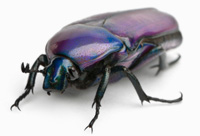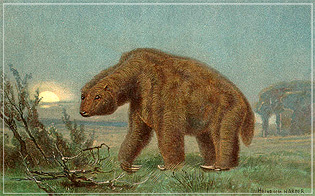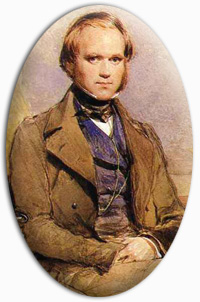Who was Darwin anyway?
Charles Darwin – beetles, worms and big ideas
He is one of the best known scientists there has ever been, but why is Charles Darwin so famous?
 Darwin spent his whole life (including much of his childhood) being fascinated by the natural world around him. As an eight year old boy he was already collecting specimens whilst at school and later on he had a craze for beetle-collecting, getting some of his finds published in a book of entomology.
Darwin spent his whole life (including much of his childhood) being fascinated by the natural world around him. As an eight year old boy he was already collecting specimens whilst at school and later on he had a craze for beetle-collecting, getting some of his finds published in a book of entomology.
All aboard…
Still a young man in his early twenties, he took the voyage of a lifetime when he set sail in The Beagle two days after Christmas in 1831, spending the next five years sailing all over the world chiefly exploring the continent of South America and neighbouring island groups such as The Falklands and The Galapagos.
 Intrigued by the small differences between species of birds and animals according to which island they came from, he began to put together his brilliant theory of n
Intrigued by the small differences between species of birds and animals according to which island they came from, he began to put together his brilliant theory of n atural selection.
atural selection.
Despite feeling very sea-sick for much of the time, he kept careful notes of all his zoological and botanical observations and sent many specimens of what he found back to England. He even sampled the plankton in the sea around the ship – only in calm weather though!
Intrigued by the small differences between species of birds and animals according to which island they came from, he began to put together his brilliant theory of natural selection. This fundamental theory, which is still held today, predicts that those organisms (plants and animals) that are really well-suited, or ‘adapted’ to their local environment (salty, dry, cold, wet, dark …) will be the ones to thrive and breed and through breeding (‘reproductive success’) will pass on their genes and particular characteristics (beak shape, colour, speed, intelligence) to the next generation.
 One BIG moment during an on-shore expedition in Patagonia was when Darwin identified the fossil bones of a huge, extinct mammal, called a megatherium (which literally means Giant Beast). Megatherium was a type of giant sloth, which when standing on its hind legs was about 6 metres tall – that’s BIG! It had five sharp claws on each foot and may have lived singly in caves.
One BIG moment during an on-shore expedition in Patagonia was when Darwin identified the fossil bones of a huge, extinct mammal, called a megatherium (which literally means Giant Beast). Megatherium was a type of giant sloth, which when standing on its hind legs was about 6 metres tall – that’s BIG! It had five sharp claws on each foot and may have lived singly in caves.
Darwin brought the huge, fossil bones back to England, where they caused quite a stir!
Back home in England…
Darwin loved to talk about his ideas and excelled at taking opportunities to learn more from everyone he met. As well as discussing his theories with expert naturalists, he talked to farmers and pigeon fanciers as well as relatives, vicars, servants and neighbours. One of his uncles pointed out a patch of ground where some ash had disappeared and suggested that this was the work of earthworms.  This simple observation led to an important new Darwinian theory on the role of earthworms in soil formation.
This simple observation led to an important new Darwinian theory on the role of earthworms in soil formation.
 Darwin did not use the word ‘evolution’ when first describing his theory. Instead he talked about it as ‘descent wit
Darwin did not use the word ‘evolution’ when first describing his theory. Instead he talked about it as ‘descent wit h modification’
h modification’
Darwin did not use the word ‘evolution’ when first describing his theory. Instead he talked about it as ‘descent with modification’ (changes occurring within a species after a few or many generations). He pictured all living things, plants and animals, as being joined up like a tree with branches and twigs. The trunk of the tree represents the simple forms of life (like bacteria) from which everything else has evolved. Darwin understood that humans were no exception to this evolutionary process – they too were one of the twigs on one of the branches in the evolutionary history of life.

Darwin’s theory of evolution had a mixed reaction when it was first published in 1859. The biggest criticisms came from fellow ‘scientists’ (although they were not called scientists in Darwin’s time) who thought that the theory involved too much speculation.  Today we have far more evidence to support the theory of evolution, much more than in 1859. Darwin’s old geology teacher, the Rev. Adam Sedgwick at Cambridge University, did not like the theory because it was not ‘scientific’ enough and he also thought it went against the special nature of humans.
Today we have far more evidence to support the theory of evolution, much more than in 1859. Darwin’s old geology teacher, the Rev. Adam Sedgwick at Cambridge University, did not like the theory because it was not ‘scientific’ enough and he also thought it went against the special nature of humans.
Until 1859 nearly everyone thought that species were ‘fixed’ and would not change or evolve and that there was no ‘tree’ of evolution joining up the whole of life. Most people thought that each major form of animal or plant was created separately. But after 1859 people started to realise that the creation was all joined up with species able to change into new species.
It is wrong to think that the Church was uniformly opposed to Darwin’s theory when it was first published. In fact the earliest written document we have responding to Darwin’s Origin of Species, is a letter written by one of Darwin’s friends, the Revd Charles Kingsley. In the letter he stated that he found Darwin’s book awesome!
 Until 1859 nearly everyone thought that species were ‘fixed’ and would not change or evolve and that there was no ‘tree’ of evolution joining up
Until 1859 nearly everyone thought that species were ‘fixed’ and would not change or evolve and that there was no ‘tree’ of evolution joining up  the whole of life
the whole of life
Other church leaders (like the Bishop of Oxford, Samuel Wilberforce) were not so sure, but within a decade or so evolution was widely accepted and in many cases actively promoted within the churches of both Britain and America.
Darwin’s argument focused (as with the title of his famous book) on the origin of species, trying to explain where we all came from. Darwin argued that if evolution is a valid theory, then logically we must all have a common ancestor (common ancestor means a life form that we are all descended from, no matter how distantly).
Darwin’s scientific career had lots of setbacks. He was often very unwell for long periods of time. He experienced terrible grief at the loss of three of his ten children, in particular his most loved daughter, Annie, when she was ten. He knew that his theory, which involved so much death and suffering, challenged the idea of a personal, loving God, and that this caused distress to his wife Emma who was a devout believer, and someone he loved very much.  Darwin stopped attending church in later life, although he never denied the existence of God. He thought it was possible to believe in God and be an evolutionist.
Darwin stopped attending church in later life, although he never denied the existence of God. He thought it was possible to believe in God and be an evolutionist.
Even during his periods of illness, Darwin’s curiosity about the natural world could not be curbed. He is described as lying on his sickbed in a room stuffed with elaborate experiments to observe the growth of climbing plants.
Charles Darwin died at his home in Down House on 19th April 1882, age 73 years. He had been a relentless chaser of ideas, through the close observation of nature, both in his own garden and the wide world beyond. He is buried in Westminster Abbey alongside kings, queens, writers, poets and other scientists.